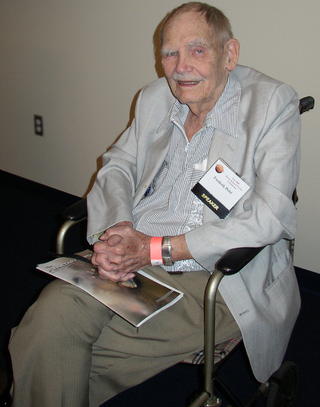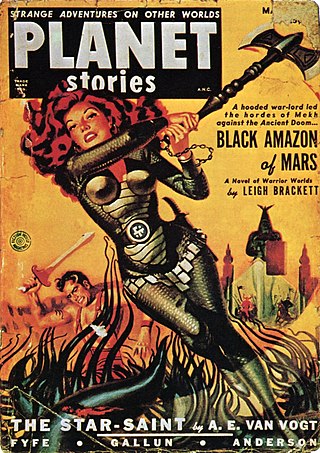Related Research Articles

Frederik George Pohl Jr. was an American science-fiction writer, editor, and fan, with a career spanning nearly 75 years—from his first published work, the 1937 poem "Elegy to a Dead Satellite: Luna", to the 2011 novel All the Lives He Led.

Isaac Asimov was an American writer and professor of biochemistry at Boston University. During his lifetime, Asimov was considered one of the "Big Three" science fiction writers, along with Robert A. Heinlein and Arthur C. Clarke. A prolific writer, he wrote or edited more than 500 books. He also wrote an estimated 90,000 letters and postcards. Best known for his hard science fiction, Asimov also wrote mysteries and fantasy, as well as popular science and other non-fiction.

Yevgeny Ivanovich Zamyatin, sometimes anglicized as Eugene Zamyatin, was a Russian author of science fiction, philosophy, literary criticism, and political satire.

Nemesis is a science fiction novel by American writer Isaac Asimov. One of his later science fiction novels, it was published in 1989, three years before his death. The novel is loosely related to the future history of his Robot Series, Empire Series, and Foundation Series, into which Asimov attempted to integrate his science fiction output. This novel is connected to Asimov's other works by several ideas from earlier and later novels, including non-human intelligence, sentient astronomical bodies ("Hallucination"), and rotor engines.
This article contains information about the literary events and publications of 1920.

Janet Opal Asimov, usually writing as J. O. Jeppson, was an American science fiction writer, psychiatrist, and psychoanalyst.

We is a dystopian novel by Russian writer Yevgeny Zamyatin, written in 1920–1921. It was first published as an English translation by Gregory Zilboorg in 1924 by E. P. Dutton in New York, with the original Russian text first published in 1952. The novel describes a world of harmony and conformity within a united totalitarian state. It influenced the emergence of dystopia as a literary genre. George Orwell said that Aldous Huxley's 1931 Brave New World must be partly derived from We, although Huxley denied this. Orwell's own Nineteen Eighty-Four (1949) was also inspired by We.

Drexel Jerome Lewis Bixby was an American short story writer and scriptwriter. He wrote the 1953 story "It's a Good Life", which was included in The Science Fiction Hall of Fame. It formed the basis of a 1961 episode of The Twilight Zone and was remade in Twilight Zone: The Movie (1983). He wrote four episodes for the Star Trek series: "Mirror, Mirror", "Day of the Dove", "Requiem for Methuselah", and "By Any Other Name". With Otto Klement, he co-wrote the story upon which the science fiction movie Fantastic Voyage (1966), the related television series, and the related Isaac Asimov novel were based. Bixby's final produced or published work so far was the screenplay for the 2007 science fiction film The Man from Earth.

David Lindsay was a Scottish author best remembered for the philosophical science fiction novel A Voyage to Arcturus (1920).

Fantastic Voyage is a 1966 American science fiction adventure film directed by Richard Fleischer and written by Harry Kleiner, based on a story by Otto Klement and Jerome Bixby. The film is about a submarine crew who is shrunk to microscopic size and venture into the body of an injured scientist to repair damage to his brain. In adapting the story for his script, Kleiner abandoned all but the concept of miniaturization and added a Cold War element. The film starred Stephen Boyd, Raquel Welch, Edmond O'Brien, Donald Pleasence, and Arthur Kennedy.
Multivac is the name of a fictional supercomputer appearing in over a dozen science fiction stories by American writer Isaac Asimov. Asimov's depiction of Multivac, a mainframe computer accessible by terminal, originally by specialists using machine code and later by any user, and used for directing the global economy and humanity's development, has been seen as the defining conceptualization of the genre of computers for the period (1950s–1960s). Multivac has been described as the direct ancestor of HAL 9000.

Planet Stories was an American pulp science fiction magazine, published by Fiction House between 1939 and 1955. It featured interplanetary adventures, both in space and on some other planets, and was initially focused on a young readership. Malcolm Reiss was editor or editor-in-chief for all of its 71 issues. Planet Stories was launched at the same time as Planet Comics, the success of which probably helped to fund the early issues of Planet Stories. Planet Stories did not pay well enough to regularly attract the leading science fiction writers of the day, but occasionally obtained work from well-known authors, including Isaac Asimov and Clifford D. Simak. In 1952 Planet Stories published Philip K. Dick's first sale, and printed four more of his stories over the next three years.

Lucky Starr is the hero of a series of science fiction books by Isaac Asimov, using the pen name "Paul French" and intended for children.
"Waterspider" is a science fiction short story by American writer Philip K. Dick, first published in the January 1964 edition of If magazine.
The Golden Age of Science Fiction, often identified in the United States as the years 1938–1946, was a period in which a number of foundational works of science fiction literature appeared. In the history of science fiction, the Golden Age follows the "pulp era" of the 1920s and 1930s, and precedes New Wave science fiction of the 1960s and 1970s. The 1950s are, in this scheme, a transitional period. Robert Silverberg, who came of age then, saw the 1950s as the true Golden Age.

A Voyage to Arcturus is a novel by the Scottish writer David Lindsay, first published in 1920. An interstellar voyage is the framework for a narrative of a journey through fantastic landscapes. The story is set at Tormance, an imaginary planet orbiting Arcturus, which in the novel is a binary star system, consisting of the stars Branchspell and Alppain. The lands through which the characters travel represent philosophical systems or states of mind as the main character, Maskull, searches for the meaning of life. The book combines fantasy, philosophy, and science fiction in an exploration of the nature of good and evil and their relationship with existence. Described by critic, novelist, and philosopher Colin Wilson as the "greatest novel of the twentieth century", it was a central influence on C. S. Lewis' Space Trilogy, and through him on J. R. R. Tolkien, who said he read the book "with avidity". Clive Barker called it "a masterpiece" and "an extraordinary work ... quite magnificent".

The literary genre of science fiction is diverse, and its exact definition remains a contested question among both scholars and devotees. This lack of consensus is reflected in debates about the genre's history, particularly over determining its exact origins. There are two broad camps of thought, one that identifies the genre's roots in early fantastical works such as the Sumerian Epic of Gilgamesh. A second approach argues that science fiction only became possible sometime between the 17th and early 19th centuries, following the scientific revolution and major discoveries in astronomy, physics, and mathematics.
A fix-up is a novel created from several short fiction stories that may or may not have been initially related or previously published. The stories may be edited for consistency, and sometimes new connecting material, such as a frame story or other interstitial narration, is written for the new work. The term was coined by the science fiction writer A. E. van Vogt, who published several fix-ups of his own, including The Voyage of the Space Beagle, but the practice exists outside of science fiction. The use of the term in science fiction criticism was popularised by the first (1979) edition of The Encyclopedia of Science Fiction, edited by Peter Nicholls, which credited van Vogt with the creation of the term. The name “fix-up” comes from the changes that the author needs to make in the original texts, to make them fit together as though they were a novel. Foreshadowing of events from the later stories may be jammed into an early chapter of the fix-up, and character development may be interleaved throughout the book. Contradictions and inconsistencies between episodes are usually worked out.

Isaac Asimov Presents The Great SF Stories 13 (1951) is a collection of science fiction short story, edited by Isaac Asimov and Martin H. Greenberg, part of a series that which attempts to list the great science fiction stories from the Golden Age of Science Fiction. They date the Golden Age as beginning in 1939 and lasting until 1963. It was the first book in the series to not be reprinted as part of the Isaac Asimov Presents The Golden Years of Science Fiction series. This volume was originally published by DAW books in July 1985.
References
- ↑ "Isaac Asimov". The Telegraph. October 16, 1992. Archived from the original on December 1, 2016. Retrieved July 20, 2018.
- ↑ Jonas, Gerald. "William Tenn, Satirical Science Fiction Author, Dies at 89". nytimes. Retrieved July 20, 2018.
- ↑ "Obituary: Richard Adams". BBC News. December 27, 2016. Retrieved July 20, 2018.
- ↑ III, Harris M. Lentz (2006). Obituaries in the Performing Arts, 2005: Film, Television, Radio, Theatre, Dance, Music, Cartoons and Pop Culture. McFarland. p. 82. ISBN 9780786424894.
- ↑ "Ray Bradbury". The Telegraph. June 6, 2012. Retrieved July 20, 2018.
- ↑ "Frank Herbert | American author". Encyclopedia Britannica. Retrieved July 20, 2018.
- ↑ Mamczak, Sascha; Pirling, Sebastian; Jeschke, Wolfgang (2013). Das Science Fiction Jahr 2013 (in German). Heyne Verlag. p. 900. ISBN 9783641105952.
- ↑ "Yevgeny Zamyatin | Biography & Books". Encyclopedia Britannica. Retrieved July 20, 2018.
- ↑ Moorcock, Michael (August 30, 2002). "Review: A Voyage to Arcturus by David Lindsay". the Guardian. Retrieved July 20, 2018.
- ↑ Horn, Pierre L. (1991). Handbook of French Popular Culture. Greenwood Publishing Group. p. 234. ISBN 9780313261213.
- ↑ "City of Endless Night on Goodreads".
- ↑ Donahue, Neil H. (2005). A Companion to the Literature of German Expressionism. Camden House. p. 325. ISBN 9781571131751.
- ↑ Rhodes, Gary Don (1997). Lugosi: His Life in Films, on Stage, and in the Hearts of Horror Lovers. McFarland. p. 8. ISBN 9780786402571.